A brief history of woodturning
Introduction
Information about woodturning before the 13th century AD is
sparse. What information we have is derived from:
1) a single pictorial representation of a lathe from the 3rd
century BC;
2) a few references to lathes and turning in Greek and Roman
literature; and
3) a limited quantity of the physical remains of turned
products and turned waste.
Because of the last of these we know that woodturning has been
practised from at least the 6th century BC and possibly for
several hundred years prior to that. Although the information
on the early development of woodturning is sparse it is
surprising how much it tells us when it is interpreted in the
light of information from later periods. Our story will begin
with the lathe.
|
Products of the lathe
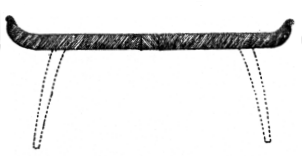 Fig 1: The Mycenean Wooden Bowl
Fig 1: The Mycenean Wooden Bowl
Circa 1200 BC
|
|
It has been seen that the first evidence of the lathe itself
comes from the 3rd century BC but it is known that it was in
use long before that. A flat wooden dish which stood on wooden
legs was found in a pit grave at Mycenae dated at 1100 to 1400
BC. This dish has low side walks with a bead running around the
top, which is typical of turned work. There is also a hole in
the centre, which has been plugged. This suggests that it could
have been turned on a mandrel held between centres in a lathe.
Against this view must be set the fact that there is no sign of
turned grooves on the piece.
|
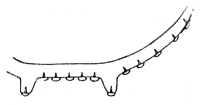 Fig 2: Part of a bowl found at Corneto
Fig 2: Part of a bowl found at Corneto
Dated as from 700 BC
|
|
When we move forward in time a few hundred years we find
clear evidence that the Etruscans (who lived in the region
which is now northern Italy) possessed well developed
techniques of turning. The earliest piece from that area was
found at a site known as the "Tomb of the Warrior" at Corneto.
This is a fragment of a wooden bowl, dated at around 700 BC,
which shows "clear evidence of rounding and polishing on its
outer surface and of hollow turning..." (Woodbury) Other
Etruscan turned vessels were found on this site. |
|
|
The next few generations of Etruscans must have continued to
develop the skills of their forefathers. Examples of their work
from the 6th century BC have been found in substantial
quantities. These include turned ornaments for hairpins, amber
beads and some turned wooden platters.
The Etruscans were not the only people to use the lathe in that
period. Excavations of a mound grave in Asia Minor (now Turkey)
revealed two flat wooden dishes with decorative turned rims.
These have been dated as from the 7th century BC. A number of
turned wooden boxes and bowls from the 5th century BC have been
found in the Crimea. One of these is described by Woodbury as a
"double box" made in one piece with a separate cover which
"shows highly sophisticated skills in turning". |
 Fig 3: Bowl found at Uffing in Upper Bavaria
Fig 3: Bowl found at Uffing in Upper Bavaria
Dated as from 6th C. BC
|
|
The oldest complete turned artefact discovered was a bowl
from about the 6th century BC that was found in the late 19th
century by Julius Naue in a burial ground at Uffing in Upper
Bavaria. Although the early turner's equipment was, of
necessity, very primitive this does not mean that the turner
was lacking in ability; this bowl provides strong evidence of
very considerable skill. It is not simply a utilitarian piece,
such as those, which were produced, in great quantity in
England in Medieval times, but takes the form of a goblet with
a stem and base. Not only was it decorated with beads but it
also had a large captive ring around the stem. It was a very
sophisticated article to have been produced by such primitive
means.
How much more difficult was turning for him than it is for us;
what kind of lathe did he use? This question provides a
convenient link to the consideration of the history of the
lathe itself, rather than at the objects that were made on it.
|
The history of the lathe
Types of lathe
(1) The strap lathe
(2) The bow lathe
(3) The pole lathe
(4) The great Wheel
(5) The treadle lathe
|
|
|
The list in the box on the left represents a very
rough attempt to set out the chronological development of the
lathe. It is imprecise because no-one knows exactly at what
date any of them first came into existence. It should also be
noted that the earlier lathes were not made obsolete as soon as
a new type came into existence. Indeed, examples of all of them
can be found in very modern times.
One aspect of the problem of dating is that no physical remains
of the lathe itself have been found from before the 10th
century AD, at the very earliest. The only evidence we have of
the nature of early lathes is that of a documentary nature.
|
The strap lathe
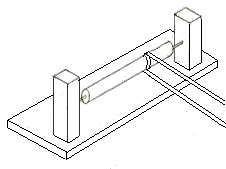 Fig 4: Schematic diagram of a strap
lathe
(tool rest not shown)
Fig 4: Schematic diagram of a strap
lathe
(tool rest not shown)
|
|
On these lathes the work-piece is held between two iron spikes
supported by a crude wooden framework. The tool rest is formed
by a long rod, which runs parallel to the axis. The motive
power is transmitted by a strap which takes a couple of turns
around the end of the work-piece; the strap is pulled backwards
and forwards by the turner's assistant to provide a
reciprocating motion. Usually, both the turner and his
assistant had to sit on the ground to operate this device. |

Fig 5: Depiction of turmer at work - 3rd C.
BC
|
|
A turner from ancient Egypt
The earliest information on the lathe dates from the 3rd
century BC. This is a bas-relief carving on the wall of the
grave of an Egyptian called Petrosiris. This carving shows a
craftsman and his assistant busy on a bow lathe very similar to
those, which have been found in use in Egypt in modern times.
|
|
|
The image on the left which is taken from a book published in
1881 (Hand or Simple Turning - Principles and Practice by John
Holtzapffel) portrays an Indian turner. The author states that
"He commences by digging two holes in the ground at a distance
suitable for the length of the work, and in these fixes two
short wooden posts, securing them as firmly as he can by
ramming earth and driving in wedges and stones around them. The
centres, scarcely more then round nails or spikes, are driven
through the posts at about eight inches from the ground, and a
wooden rod for the support of the tools, is either nailed to
the posts or tied to them by a piece of coir or coconut rope.
The bar if long is additionally supported ... by one or two
vertical sticks driven into the ground. During most of his
mechanical operations the Indian workman is seated on the
ground ... The boy, who gives motion to the work, sits or
kneels on the other side of it holding the ends of cord wrapped
around it in his hands, pulling them alternately ...". Notice
that in this instance the turner is using his toes to steady
the tool on the rest. |
|
|
A lathe of a very similar type was still in use
in Ethiopia in the late 1960's when Nancy Boothby (an American
teacher) took the photographs on the left showing the bowl
turner at work. (Please note that the copyright to the images
shown in Fig.s 7a to 7g is owned by Taunton Press. These images
are reproduced here with its permission.) Fig 7a shows the work
piece held between centres made by driving two 6 inch metal
spikes into logs embedded in the ground. The end the tool rest
support was placed on one of the metal centres and the tool
rest itself was laid across that. the turner held the rest in
place with his feet. The assistant pulled forward and back on a
leather strap wrapped around the mandrel. |
|
|
|
The Ethiopian bowl maker did the shaping with a
primitive axe/adze. This had three interchangeable socketed
heads which fitted on a single crooked handle. the handle was
made utilising the natural shape of a branch. This device was
similar to those used by the ancient Egyptians. But the latter
did not have a socketed head, instead the flat blade was lashed
onto the handle with leather or sinew. However, it is thought
that a socketed head was used in parts of Asia in the ancient
world. |
|
|
|
Turning by these methods is very heavy work so
to reduce the effort the blank is shaped as much as possible,
inside as well as out, before it is turned. However, because
the bowl is held between centres a spigot is left in the middle
of the inside until the turning is completed. Similar
roughouts, from the late Iron Age, have been found in Britain.
|
|
|
|
With the roughout held between his feet the bowl
turner drilled a hole in the centre of the bottom. The drill,
which could hardly have been more primitive, was simply rolled
between his hands. |
|
|
|
The mandrel was then driven securely into the
bottom of the roughout. The mandrel was a piece of branch wood
with a tapered end sheathed in metal. The metal sheath is not
essential but it speeds up the process - without it time would
have to be spent making a mortise and tenon joint. |
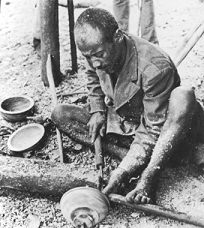
|
|
The bowl was then turned. Local abrasive leaves, probably
from the fig tree, were used for sanding. But little sanding
was required because of the smoothness of the cuts. The knobs
on the top and the bottom were finally removed with the adze
and the rough areas smoothed over with the turning tool.
|
The Bow Lathe
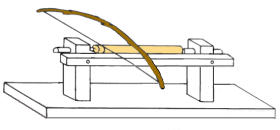 Fig 8: Schematic diagram of bow
lathe
Fig 8: Schematic diagram of bow
lathe
|
|
The bow lathe is very similar to the strap lathe
but the motive power is supplied by a bow. The string of the
bow is wrapped around the work piece and a reciprocating motion
is created by moving the bow backwards and forwards. Whereas
the strap lathe requires two people to work it the bow lathe
requires only one. The drawback is that less power is available
and the turner has only one hand with which to control the
tool. In some cases the turner used his foot to help to steady
the the tool. Because of these deficiencies only small work is
done on the bow lathe. |
|
|
|
Turning backgammon and chess pieces
with a bow lathe.
From King Alonso X's Book of games of 1283 |
|
|
|
Fig 10 on the left shows a Persian turner at
work on a bow lathe as described by Holtzapffel: "In his lathe
the centres are made to pass through the the ends of an open
box the edge of which serves as the support for the tool; they
are raised or lowered to suit work of different diameters in a
series of holes pieced in a vertical line. Small works are set
in motion by the bow, both by the Persian and the Indian, for
those of larger diameter, both use a cord pulled by an
assistant |
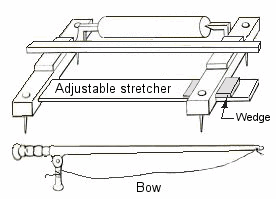
 Fig 11: An Egyptian lathe - 1873
Fig 11: An Egyptian lathe - 1873
|
|
Fig 11 is based on a sketch made by Holtzapffel in a turner's
shop in Cairo in 1873. Although this was crudely constructed it
presented several improvements on the lathes of the Indian and
the Persian turners shown above. It was more robust,
self-contained, adjustable, and portable. Holtzapffel described
the way it was used as follows: "The operator sits upon one
heel, the toes of the foot going just under or upon the
stretcher and he directs the tool, which he holds by a long
handle, with the toes of the other foot .... Occasionally and
for heavy work, both feet are advanced, placed close together,
and press on the tool on the bar by the big toes, the other
toes closely pressed around the tool and on the bar; while the
latter is always pushed forward by the feet ..... . The bow
presented a peculiarity in the hinged piece near the handle,
employed to regulate the tension in the string; the string is
wrapped once or twice around the work, after which it is
twisted around the jointed piece, which is then folded back and
held in the hand with the handle." |
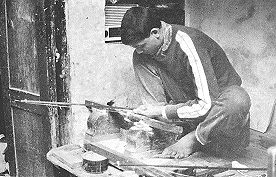
Fig 12: An Egyptian boy at work -
1960's
Larger image
|
|
There is evidence that a bow lathe very similar
to that used by the ancient Egyptians was in use in the same
area in the early 1960's. I have a book, which contains a
photograph of an Egyptian boy working a bow lathe by himself:
his right hand is working the bow, his left hand is
manipulating the tool. It is not clear what he is making but
whatever it is it is very small. |
The pole lathe
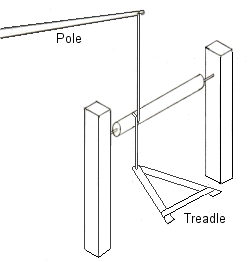 Fig 13: Schematic diagram of a pole lathe
Fig 13: Schematic diagram of a pole lathe
(The tool rest and other features are omitted)
|
|
The pole lathe was invented sometime before the 13th century
AD. Although it represented a great advance the pole lathe was
not that much more complicated than its predecessors. The
differences consisted of a framework to raise the bed of the
lathe clear of the ground, the addition of a pole and a
treadle. The basic construction is shown in the diagram. It can
be seen that the upper end of the driving cord is attached to
the tip of a flexible pole and the other end is fastened to a
simple treadle arrangement below the bed of the lathe. It
should be noted that function of the pole is to act as a return
spring and to keep the string taught - nothing more.
For its time this was a major technological breakthrough; it
not only freed the turner from the need for an assistant but
also enabled him to stand instead of having to sit on the
ground. Together these factors gave him more control over the
process; they made it possible for him to control the rhythm of
work, to apply more power and to exercise greater freedom of
movement. Many of these early lathes would have been portable
enabling them to be set up near the raw material, or near the
customer, whichever was the more convenient. Others, however,
particularly those for turning bowls may have been fairly
substantial constructions being heavy and rigid.
|
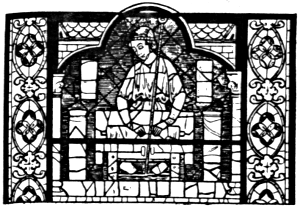 Fig 12: Stained glass window - 13th C
Fig 12: Stained glass window - 13th C
|
|
It is not known when or where the pole lathe first came into
use. It has been suggested that its origins date back to at
least to the Saxon period in Europe but this is speculation.
The first clear evidence of its use comes from two sources in
the 13th Century. One of these is a manuscript illumination of
a nun turning a bowl and the other is a stained glass window in
Chartres Cathedral. As is to be expected the window does not
provide a very clear picture but we know it shows a turner at
work because it was donated to the Cathedral by the local
Turner's Guild. It must depict a pole lathe because the cord
can be seen running down the centre of the window. |
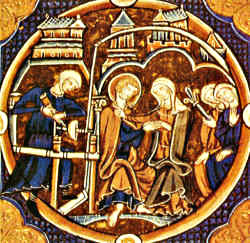 Fig 15: Manuscript illumination - 13th C.
Fig 15: Manuscript illumination - 13th C.
|
|
Fig. 15 shows a nun at work on what is clearly a
pole lathe. The lathe appears to be of relatively light
construction but this may be due to artistic licence. In common
with many early illustrations of the lathe the tool rest is not
shown.
Source: La Bible Moralisee |
|
|
|
Fig. 16 shows a turner working on a
pole lathe which is much more robust than that shown in Fig.
13. Here, again, the toolrest is not shown. It is not clear
what the tuner is making but it could be the hub of a wheel.
Source: Mendelsches Bruderbuch 1395
|
|
|
|
Fig. 17 is interesting because it depicts some
of the items that the turner had made. These include dishes,
bowls, large spindle turnings, and what appear to be musical
instruments (the latter are on the bench in the foreground on
the left). The large sphere on which the turner is working is a
puzzle: what is it and what would it have been used for? It
does show that large, weighty, objects could be turned on the
pole lathe.
Source: woodcut in the "Panoplia Omnium" by Hartman Schopper,
published at Frankfort-on-the-main in 1568 |
|
|
|
Fig. 18 also shows some of the turner's
products, namely a chair and a spinning wheel. The bowl perched
on top of the headstock would have contained oil that the
turner used to lubricate the metal points holding the
work-piece. This lathe can be compared with the one shown in
Fig.16 above. In the latter the the bed of the lathe is made by
cutting a slot in a heavy board. In this lathe it is made from
separate pieces of timber bolted onto posts - together these
form the frame of the lathe.
On the shelf on the back wall are a number of objects which
have been identified by Pinto as "three footwormers, a spice(?)
box, a yoke, flour barrels, etc." Did the turner make these or
was it just a convenient place to store them?
Source: copper engraving by the Dutch artist Jan Joris Van
Vliet (born at Delft in 1610) |
|
|
|
The illustration of a pole lather on the left is taken from
Joseph Moxon's book "Mechanic Exercises or the Doctrine of
Handy-Works". This was published in 1678 and was the first
English book to describe and illustrate the tools of various
trades and the way they are used; in effect it was the first of
a long line DIY manuals. Moxon's illustration are a little
crude by today's standards because he not only had to prepare
the drawings but engrave the plates himself.
Note the bar in the foreground which rests on two supports.
Moxon tells us that it was called the Seat "not because it was
so but because the Workman places the upper part of his
Buttocks against it, that he may stand the steddier to his
Work, and consequently guide his foot the firmer and exacter".
The use of the seat by pole lathe tuners seems to have been a
matter of personal preference. Some used it, others did not.
|
|
|
|
Fig. 20 shows a turner making a
large baluster. This illustration is from a book published
nearly 90 years after Moxon's. The lathe is essentially the
same as that used by the pole lathe turner in the 1395. (see
Fig. 16)
Source: T. H. Coker and others, The Complete dictionary of
Arts and Sciences (1764-6), Vol. III. |
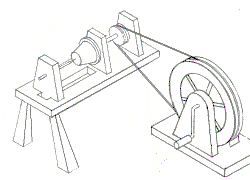 Fig 21: Schematic diagram of possible Roman lathe
Fig 21: Schematic diagram of possible Roman lathe
|
|
The great
wheel
There is some evidence from a detailed examination of bronze
vessels that the Romans employed lathes using continuous
motion. It has been suggested that the drive could have been
provided by means of a pulley system utilising an independent
"great wheel" as illustrated in Figure 21. (See Caroline
Earwood - Domestic Wooden Artefacts in Britain and Ireland From
Neolithic to Viking Times) |
|
|
|
Fig. 22 shows a great wheel in use
in a pewter turner's work-shop in the middle of the 16th
century. The figure in the background appears to be sitting in
front of a fire wielding a soldering iron. The similarities
between this image and that in Fig 17 showing a pole lathe
turner are striking.
Source: Book of Trades - Jost Amman - 1568 |
|
|
|
A great wheel in a wheelwright's
shop in modern times. Probably used for turning wheel hubs.
Writing in 1881 Holtzapffel says that the great wheel (or as he
calls it the hand fly wheel) "has been very generally
supplanted by power, nevertheless is still remains in use for
many industries, it is convenient for occasional purposes in
all workshops, while it has the recommendation over most
motors, of simplicity and almost impossibility of derangement.
The largest and lightest handwheels are those used by the soft
wood turners; these are made of wood with spokes very like the
wheel of a carriage, and measure from six to eight feet in
diameter." |
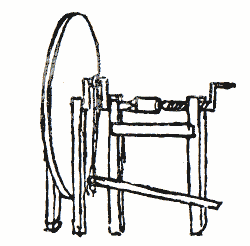 Fig 24: Leonardo's lathe c1500.
Fig 24: Leonardo's lathe c1500.
|
|
The treadle, or foot wheel,
lathe
This sketch (Fig. 24) by Leonardo de Vinci is the first known
illustration of a treadle lathe.It is not known whether it is a
drawing of a lathe he had seen or if it is another of his
original concepts. Whichever it is it is not a practical
machine because it would turn too slowly. |
|
|
|
Fig. 25 (Coker ibid) shows how the turning speed
for a treadle lathe was increased by using a flywheel and belt
to drive a small pully on the headstock. Note that the flywheel
and the pulley are provided with a number of stepped grooves so
that a variety of speed ranges could be obtained by moving the
belt.
|
 Fig 26: Treadle lathe - late17th C or early 18th
C.
Fig 26: Treadle lathe - late17th C or early 18th
C.
Larger
image
|
|
The lathe shown in Fig. 26 is set up for ornamental turning.
Ornamental turners are able to create patterns on the work and
obtain forms which are not possible with hand turning.
Ornamental turning has always been very much a minority hobby -
in its early days it was practised by by members of the upper
echelons of society, including royalty. It is still done today
by enthusiasts, some of whom use antique machines similar to
the one illustrated here. Good antique machines command very
high prices. Examples of ornamental turnings can be seen on the
website of The society of
Ornamental Turners |
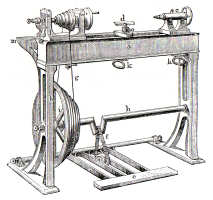
|
|
The lathe shown if Fig. 27 is made entirely of
metal and is a robust machine. Despite the existence of such
machines the pole lathe was preferred by many hand turners and
it lingered on well into the 20th century. To quote Holtzapffel
again: "The exclusive or even general use of the footwheel for
the lathe, was probably considerably retarded, first, by the
very simple and economical nature of the pole lathe, and then,
by imperfections in the construction and in the manner in which
the employment of the wheel was first attempted.". After small
electric motors became available treadle lathes became museum
pieces |
Tailpiece
 Fig 28 Lathe for turning locomotive wheels in
mid-19th C.
Fig 28 Lathe for turning locomotive wheels in
mid-19th C.
Larger image
This image has been added to provide some perspective. Until
the beginning of the 19th century the tools for turning both
wood and metal were handheld. In the early years of the century
Henry Maudsley developed the slide-rest lathe for turning
metal. The tool was clamped in the rest which slid along an
accurately machined bed and was moved by a leadscrew. With the
implementation of steam power the metal cutting lathe developed
rapidly. The lathe shown above was able to turn two steam
locomotive wheels on their axle.
Source of image: A treatise on Lathes and Turning, W
Henry Northcott, 1868 |
|